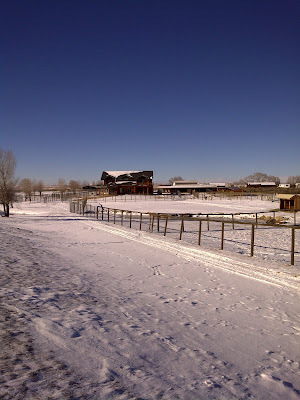Al and Sondra's Home on The Ranch
The Ellis Log Home Ready for Christmas
It was a difficult trip to make in the dead of winter and so we succumbed to the icy road conditions not long after we passed Baker City on I84. We hit a patch of snow covered ice and spun our truck around, first hitting the outside guard rail and then the inside median. A lot of damage to the front end, but we were not hurt and we were able to drive on to Ontario without any trouble. We stayed the night in Ontario and the next day, which was Sunday, we were able to find a Firestone tire company in Boise that was open. We left our truck with them for repairs that would enable us to get back to Portland. But, in the mean time we needed to rent a car to get to Wyoming. The only car rental we were able to find on a Sunday was at the Boise airport, so we rented a car and were able to continue onto Wyoming. The weather improved that day, but under the circumstances we drove it slow. We arrived at the Highline Trail Ranch at 10PM Sunday night and had an enjoyable time with Al and Sondra before we hit the sake at around midnight. Al and Sondra were the consummate hosts the entire week we stayed with them; great conversation and amazing food. 
Damage to Our Truck on the Way to Wyoming
I worked with Al on the ranch from Monday through Thursday with the goal of determining if this was the life I wanted to live for my next career. As I worked with his staff, Karen and Cathy, I learned as much as I could about the superior pack llamas that he was breeding. I don’t know of anyone else in the country that has incorporated the breeding goals which Al adopted in to his breeding program.
Pam, Al and Sondra at one of the Employee Cabins
Cathy and Karen Feeding the Boys
Joe, Al and Cathy Feeding the Boys in the Field
Joe Weighing the Llamas. They Get on the Scale One at a Time Just By Calling Their Name!
The Boys Coming in From the Field to Eat
Al is breeding what is called in the llama community, the “Classic Ccara Llama.” These llamas are specifically bred for working, which is what the word, “Ccara” means. Most Ccara llama breeders, like Al, use these llamas for trail packing and in Al’s case, packing in to the high mountains of Wyoming for multi day expeditions.
Spock, Al's Best Sire, Weighing in at Over 400 lbs.
The basic features of Classical Ccara llamas are as follows: Long and muscular legs, Muscular chest, Double coat of wool (a dense under coat and thin top coat, which is useful for working in both heat and cold), Short wool on the neck, Athletic ability, Strength for carrying heavy loads, and Endurance.
Most people in the llama breeding community use llamas for their wool and for showing in competitions. They are not as concerned with the working abilities of the animal. In fact, many Ccara llama breeders are disturbed that show competitions actually discourage the Ccara features of llamas, because judges are only looking for conformation that is suitable for beauty and not working ability. It would be like comparing Miss America with G.I. Jane. Which show girl would you want to carry your gear for 8 hours on mountains trails? Classic Ccara’s aren’t necessarily the prettiest llamas, but they are the toughest. It is believed that the Classical Ccara llama has been lost to us after Pizzaro came in to Peru in the 1500s and destroyed the great llama culture of the Inca’s. Al’s life goal is to restore these grand animals to their original working function. His llama ranch is a testament to his goals. He now has 200 Ccara llamas and he’s putting his ranch into a trust that will preserve his breeding goals after he is long gone.
Joe With a Yearling. As Large As My Four Year Old Sire, Apollo.
When I got in to llamas I soon learned about the difference between Classical Ccara Llamas and their woolly siblings. From the inception of my llama program I too have been working toward purchasing and breeding Classical Ccara llamas, but I must say that in my limited experience I haven’t seen the kind of llamas Al is breeding. At least the llamas I see in the Portland, Oregon vicinity. I would compare his llamas to the Budweiser Clydesdale horses and the ones I know in my region and experience to the normal run of the mill horse. For instance, his llamas are all between 400 and 500 pounds whereas mine are about 300 pounds. Are his better? Do they perform better? Do they have more stamina? That is a question I have yet to answer and my experience in the years to follow will help answer these questions. I have been a strength and conditioning coach for over 20 years and I have learned with humans that size does not always translate into superior performance. I’ll find out.
Six Month Olds Being Weighed. As Large As Some of My Yearlings.
We came away from Highline Llama Ranch greatly impressed, but we could not conclude that we would be compatible with the lifestyle. For now we are staying in Portland, but with a much better understanding and appreciation for the Classical Ccara Llama.


















